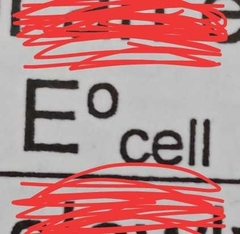![]()
![]()
![]()
Use LEFT and RIGHT arrow keys to navigate between flashcards;
Use UP and DOWN arrow keys to flip the card;
H to show hint;
A reads text to speech;
23 Cards in this Set
- Front
- Back
|
Anode |
The electrode where oxidation occurs. The electrode used in electrolytic cells that is connected to the positive terminal if the power source. |
|
|
Anion |
An ion that is negativly charged and attracted to the positive electrode in an electrolytic process. |
|
|
Battery |
Commercially produced electrochemical cell or collection of electrochemical cells. |
|
|
Cathode |
The electrode where reduction occurs. The electrode used in electrolytic cells that is the negative terminal of the power source. |
|
|
Cation |
An ion that is positively charged and attracted to the cathode in an electrolytic process. |
|
|
Dry cell |
An electrochemical cell that produces electricity from (almost) dry chemicals. The first cell of this type was made by Leclanché. |
|
|
Cell diagram |
Symbolic representation of an electrochemical cell or half-cell. |
|
|
Cell potential |

The potential, measured in volts, of an electrochemical cell to push and pull electrons through a circuit, symbol |
|
|
Corrode |
Destroy or damage usually metals slowly by chemical action. |
|
|
Electrochemical cell (galvanic cell) |
An arrangement of two half cells using chemical reactions to produce an electric current. |
|
|
Electrochemistry |
The study of chemical reactions to produce electric current. |
|
|
Electrodes |
The conductors placed in cells that transfer charge between the external circuit and the electrolyte. |
|
|
Electrode (Redox) Potential |
The electric potential developed by an electrode when it is joined with another electrode to form an electrochemical cell. The potential is commonly standardised against the hydrogen electrode. |
|
|
Electrolyte |
A liquid, either molten or an aqueous solution that will conduct electricity and undergo chemical change. |
|
|
Electrolysis |
A chemical process that uses electrical energy to bring about a non-spontaneous chemical reaction. |
|
|
EMF |
Electromotive force, the potential developed by an electrochemical cell when it is an open circuit. |
|
|
External Circuit |
The circuit outside an electrochemical cell where wires connect the cell to a voltmeter or a piece of electrical equipment. |
|
|
Galvanic Cell |
An electrochemical cell (aka Voltaic Cell). |
|
|
Half Cell |
An arrangement of an electrode in an aqueous solution containing an oxidising/reducing chemical system. |
|
|
Hydrogen Electrode |
The standard electrode used to measure electrode potentials for other electrode systems. |
|
|
Lechanché Cell |
An electrochemical cell that produces electricity from (almost) dry chemicals. |
|
|
Salt Bridge |
Used to connect two half cells with a conducting medium. |
|
|
Standard Conditions |
100.0kPa (1 atmosphere) 25 degrees Celsius 1molL-1 |

